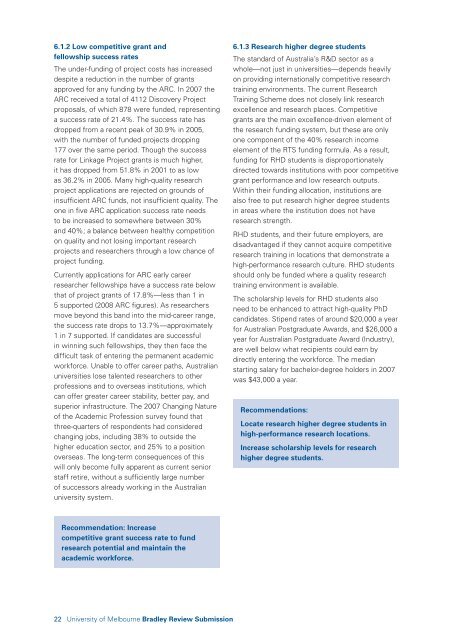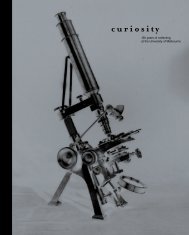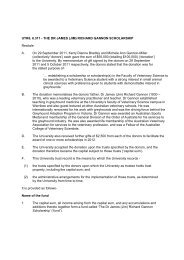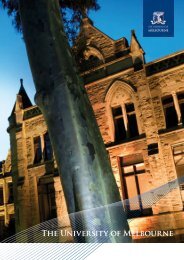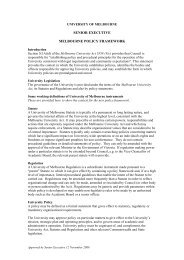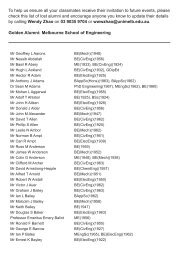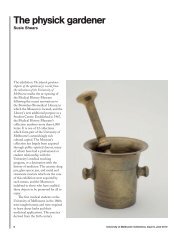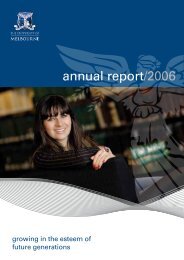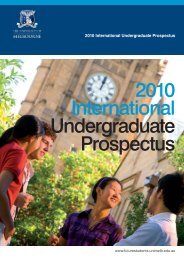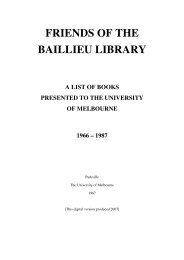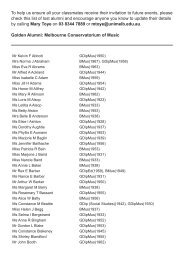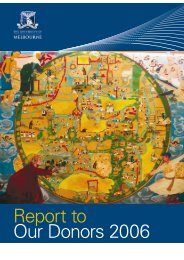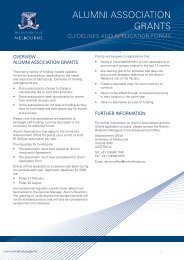Review of Australian Higher Education The Bradley Review
Review of Australian Higher Education The Bradley Review
Review of Australian Higher Education The Bradley Review
You also want an ePaper? Increase the reach of your titles
YUMPU automatically turns print PDFs into web optimized ePapers that Google loves.
6.1.2 Low competitive grant and<br />
fellowship success rates<br />
<strong>The</strong> under-funding <strong>of</strong> project costs has increased<br />
despite a reduction in the number <strong>of</strong> grants<br />
approved for any funding by the ARC. In 2007 the<br />
ARC received a total <strong>of</strong> 4112 Discovery Project<br />
proposals, <strong>of</strong> which 878 were funded, representing<br />
a success rate <strong>of</strong> 21.4%. <strong>The</strong> success rate has<br />
dropped from a recent peak <strong>of</strong> 30.9% in 2005,<br />
with the number <strong>of</strong> funded projects dropping<br />
177 over the same period. Though the success<br />
rate for Linkage Project grants is much higher,<br />
it has dropped from 51.8% in 2001 to as low<br />
as 36.2% in 2005. Many high-quality research<br />
project applications are rejected on grounds <strong>of</strong><br />
insufficient ARC funds, not insufficient quality. <strong>The</strong><br />
one in five ARC application success rate needs<br />
to be increased to somewhere between 30%<br />
and 40%; a balance between healthy competition<br />
on quality and not losing important research<br />
projects and researchers through a low chance <strong>of</strong><br />
project funding.<br />
Currently applications for ARC early career<br />
researcher fellowships have a success rate below<br />
that <strong>of</strong> project grants <strong>of</strong> 17.8%—less than 1 in<br />
5 supported (2008 ARC figures). As researchers<br />
move beyond this band into the mid-career range,<br />
the success rate drops to 13.7%—approximately<br />
1 in 7 supported. If candidates are successful<br />
in winning such fellowships, they then face the<br />
difficult task <strong>of</strong> entering the permanent academic<br />
workforce. Unable to <strong>of</strong>fer career paths, <strong>Australian</strong><br />
universities lose talented researchers to other<br />
pr<strong>of</strong>essions and to overseas institutions, which<br />
can <strong>of</strong>fer greater career stability, better pay, and<br />
superior infrastructure. <strong>The</strong> 2007 Changing Nature<br />
<strong>of</strong> the Academic Pr<strong>of</strong>ession survey found that<br />
three-quarters <strong>of</strong> respondents had considered<br />
changing jobs, including 38% to outside the<br />
higher education sector, and 25% to a position<br />
overseas. <strong>The</strong> long-term consequences <strong>of</strong> this<br />
will only become fully apparent as current senior<br />
staff retire, without a sufficiently large number<br />
<strong>of</strong> successors already working in the <strong>Australian</strong><br />
university system.<br />
6.1.3 Research higher degree students<br />
<strong>The</strong> standard <strong>of</strong> Australia’s R&D sector as a<br />
whole—not just in universities—depends heavily<br />
on providing internationally competitive research<br />
training environments. <strong>The</strong> current Research<br />
Training Scheme does not closely link research<br />
excellence and research places. Competitive<br />
grants are the main excellence-driven element <strong>of</strong><br />
the research funding system, but these are only<br />
one component <strong>of</strong> the 40% research income<br />
element <strong>of</strong> the RTS funding formula. As a result,<br />
funding for RHD students is disproportionately<br />
directed towards institutions with poor competitive<br />
grant performance and low research outputs.<br />
Within their funding allocation, institutions are<br />
also free to put research higher degree students<br />
in areas where the institution does not have<br />
research strength.<br />
RHD students, and their future employers, are<br />
disadvantaged if they cannot acquire competitive<br />
research training in locations that demonstrate a<br />
high-performance research culture. RHD students<br />
should only be funded where a quality research<br />
training environment is available.<br />
<strong>The</strong> scholarship levels for RHD students also<br />
need to be enhanced to attract high-quality PhD<br />
candidates. Stipend rates <strong>of</strong> around $20,000 a year<br />
for <strong>Australian</strong> Postgraduate Awards, and $26,000 a<br />
year for <strong>Australian</strong> Postgraduate Award (Industry),<br />
are well below what recipients could earn by<br />
directly entering the workforce. <strong>The</strong> median<br />
starting salary for bachelor-degree holders in 2007<br />
was $43,000 a year.<br />
Recommendations:<br />
Locate research higher degree students in<br />
high-performance research locations.<br />
Increase scholarship levels for research<br />
higher degree students.<br />
Recommendation: Increase<br />
competitive grant success rate to fund<br />
research potential and maintain the<br />
academic workforce.<br />
22 University <strong>of</strong> Melbourne <strong>Bradley</strong> <strong>Review</strong> Submission


